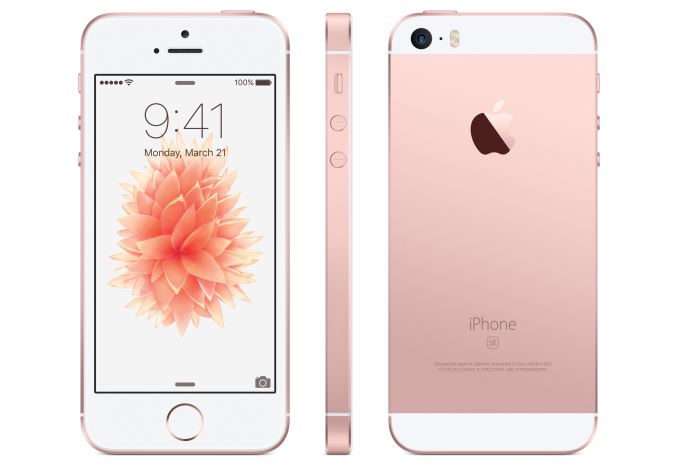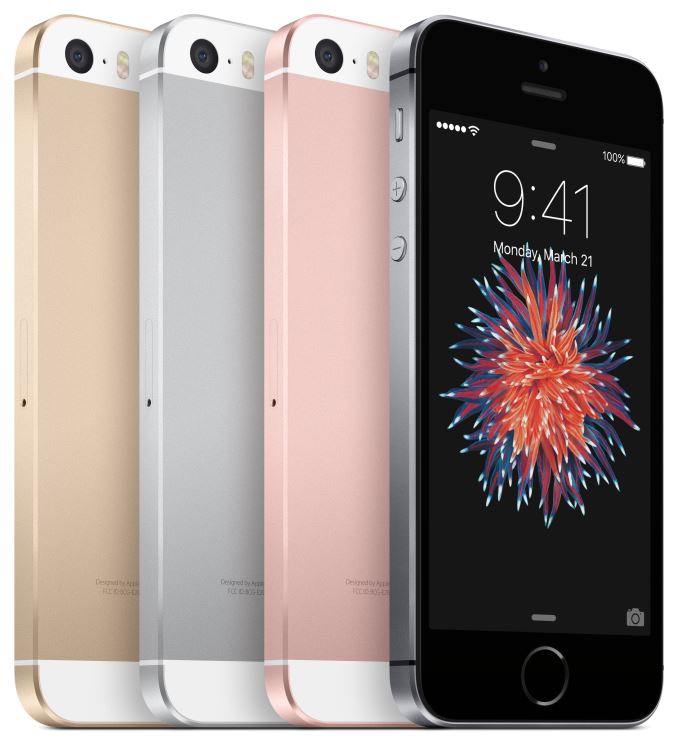Apple Announces The iPhone SE
by Brandon Chester on March 21, 2016 2:15 PM EST- Posted in
- Smartphones
- Apple

Today's Apple launch event came with three major announcements. The first was the public release date of iOS 9.3, the second was the 9.7" iPad Pro, and the third was a successor to the 2013 iPhone 5s in the iPhone SE. Interestingly, this phone eschews the number from the name of its predecessor, presumably because we've moved two generations beyond the 5s already and will likely be seeing a 7 appear in the next iPhone's name. Instead, Apple has called it the iPhone SE.
The iPhone SE comes in at a time when the high-end market has transitioned (almost) entirely to larger 5.2-inch and up smartphones. Apple was most resistant to that trend but eventually made their own larger screen devices, leaving the group of users who wanted a smaller device to opt for the aging iPhone 5s. With iOS becoming more resource intensive over time, and the iPhone 5s getting older, Apple needed to create a new 4" device if they wanted to continue offering one. Being able to offer it at a lower price than the larger models also helps with selling to new and emerging markets, especially when Apple quotes that new iPhone users tend to move towards a 4-inch device.
While the iPhone SE is a small phone, it is no slouch when it comes to the hardware, and the only aspect that is reminiscent of the iPhone 5s is the design of the chassis and the display. Almost everything else borrows from Apple's newest flagship smartphone, the iPhone 6s. You can check out the specs for the 5s, SE, and 6s in the chart below to see the similarities and differences between the three.
| Apple iPhone Line | |||
| Apple iPhone 5s | Apple iPhone SE | Apple iPhone 6s | |
| SoC | Apple A7 2 x 1.3GHz Apple Cyclone |
Apple A9 2 x Apple Twister |
|
| GPU | PowerVR GX6450 | PowerVR GT7600 | |
| RAM | 1GB LPDDR3 | 2GB LPDDR4 | |
| Display | 4.0-inch 1136 x 640 IPS LCD |
4.7-inch 1334 x 750 IPS LCD |
|
| Size / Mass | 123.8 x 58.6 x 7.6 mm 112 grams |
123.8 x 58.6 x 7.6 mm 113 grams |
138.3 x 67.1 x 7.1 mm 143 grams |
| Camera | Rear Facing 8MP iSight with 1.5µm pixels + True Tone Flash Front Facing 1.2MP F/2.4 |
Rear Facing 12MP iSight with 1.22µm pixels + True Tone Flash |
|
| Front Facing 1.2MP f/2.4 |
Front Facing 5MP F/2.2 + Retina Flash | ||
| Storage | 16GB 32GB 64GB |
16GB 64GB |
16GB 64GB 128GB |
| I/O | Apple Lightning connector, 3.5mm headset | ||
| WiFi | 2.4/5GHz Dual Band 1T1R 802.11n BT 4.2 |
2.4/5GHz Dual Band 1T1R 802.11ac BT 4.2, NFC |
2.4/5GHz Dual Band 2T2R 802.11ac BT 4.2, NFC |
| Price | 16GB: $449 | 16GB: $399 64GB: $499 |
16GB: $649 64GB: $749 128GB: $849 |
The iPhone SE is a substantial upgrade to the iPhone 5s. Starting with the internal hardware, we see that the SoC moves from the Apple A7 SoC to Apple's A9. Going by Apple's numbers, the iPhone SE's CPU performance is reported to be 2x higher than the iPhone 5s, and the GPU performance is roughly 2.85x higher.
On paper, the display is the same as the one used with the iPhone 5s. It's a 4" IPS display with a resolution of 1136 x 640. It looks like the panel is the same as well, as it doesn't benefit from the improved contrast enabled by the use of photo alignment tech on the iPhone 6s.
The camera also carries over from the 6s. Advances in sensor technology and image processing over the past two and a half years have allowed modern smartphones to greatly surpass what was possible with the camera on the iPhone 5s, and so the iPhone SE adopts the same 12MP sensor used in the iPhone 6s. This provides an increase in resolution, and the advancements that come with the A9 SoC's ISP will further upgrade image quality over the 5s through improved noise reduction, HDR, and tone mapping.
The new ISP and higher resolution sensor also allow for higher bitrate video recording with better image stabilization, as well as 30fps UHD video and 1080p120 slow motion video, which is an improvement over the relatively low bitrate 720p120 clips from the 5s. Like the iPhone 6s and 6s Plus, the iPhone SE supports taking Apple's Live Photos which pairs a video stream (MPEG) and a higher resolution still image. Since the SE doesn't have 3D Touch a user will have to interact with them using a long press in the same way that the iPad does
Connectivity on the iPhone SE improves as well. When it was launched, the 5s was only on 802.11n while some Android vendors were making an early move to 802.11ac. The SE brings 802.11ac support along for 433Mbps WiFi speeds, along with Category 4 LTE which enables downstream speeds of up to 150Mbps. This isn't on par with the Category 6 LTE in the iPhone 6s, but it's a significant improvement over the iPhone 5s. At this point we can't confirm the modem inside, which could be a number of things.
The iPhone SE starts at $399 for a 16GB model, with the upgrade to 64GB bringing the price to $499. For users still on a contract carrier in the US, it will be free on a new two-year term. Orders will begin on March 24.











43 Comments
View All Comments
Donkey2008 - Tuesday, March 22, 2016 - link
Because of Enterprise. 16GB is more then any user needs for a work phone. I know, it's a hard concept for you teenagers to understand, but you will understand once you get into the real world.ingwe - Tuesday, March 22, 2016 - link
Woah why the trolling? I happen to have an MS in Mechanical Engineering. I did not think of the enterprise market. So thank you for pointing that out. No thanks for you being a douche though.CloudWiz - Monday, March 21, 2016 - link
What do you think about Touch ID 1.0 instead of 2.0, and lack of a barometer?Confirmation of 2 GB would be great, I wouldn't put it past Apple to stick 1 GB into this phone
CloudWiz - Monday, March 21, 2016 - link
1.2 MP front facing camera as well, was really hoping both cameras would share the optics of the 6sAgent_007 - Monday, March 21, 2016 - link
"as well as from LPDDR3 to LPDDR5"LPDDR5 should be LPDDR4
menting - Monday, March 21, 2016 - link
2x higher or 2x as high? 2x higher means it's 3x as high.........Burns101 - Monday, March 21, 2016 - link
Does this come with the same badass NVME storage as the 6S?zeeBomb - Monday, March 21, 2016 - link
If it did... That's a huge plus. Im going to say no to that one, but it is a possibility.icrew - Monday, March 21, 2016 - link
Looking at http://www.apple.com/iphone-se/specs/, there are two models of the iPhoneSE: Model A1662 and Model A1723. Anyone know how that’s breaking down in terms of which carriers get which models, and how that all relates to the “SIM-free” version?I ask because my wife would like to get an SE now, but we’re hoping to switch from AT&T to Verizon once my iPhone 6 contract expires in September. I’m hoping that she might just be able to buy the SIM-free SE now, use it with her existing AT&T SIM (from her 5S), then swap her carrier over to Verizon when I get a 7+ this fall.
Any insight would be most appreciated!
KPOM - Thursday, March 24, 2016 - link
My guess is that it's the same as the iPhone 6S. The AT&T/SIM-free version has Band 30, while the other version does not. Otherwise they are identical. She can use the SIM-free version now and switch to Verizon later with no issue.